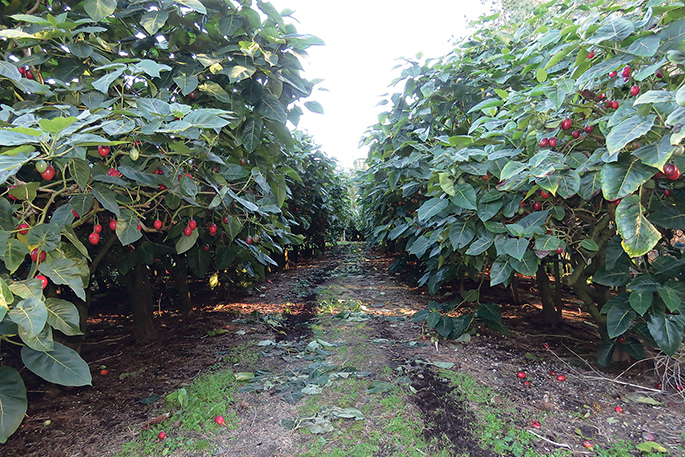Despite the Bay of Plenty’s nippy, wet winter conditions, one of New Zealand’s biggest commercial tamarillo crops is tucked away up a winding driveway, growing along hill slopes, at Pongakawa.
And it’s become a family affair with Andy and Rachel Fowler’s three young sons – Tom, 11, Mac, 9, and Hugh, 7 – all playing a part in the business.
Only 10 years ago Andy and Rachel bought 8ha of bare land, which was grazing drystock, with no plans for tamarillos.
Today, they have 3000 trees producing roughly 50 tonne per season, making it one of the largest producers of the fruit for the domestic retail market.
Their property is aptly called Ngapuke orchards. Andy says Ngapuke means ‘the hills’ – which their property has – and is a name tied to his family’s old farm at Port Waikato. “So it has a special meaning for us.”
Bare land
“We’ve had this piece of land since 2008. When we got here there was not one single tree on it,” says Andy. Today, large trees, shelterbelts and a family orchard engulf nearly every corner, making a shaded haven for the crop.
And there were no plans for tamarillos. “No way,” says Andy. “I just did a bit of a trial with one block about eight years ago and wondered how it would go. It went quite well so I put in another block and another block…next thing I knew we’d got everything we had in tamarillos.”
Andy got the idea for tamarillos from his father Bill. “He had some in – about 100 plants. I thought it would probably go quite well here – so I gave it a crack.”
The operation has also helped the family create the lifestyle they want. Being a winter crop is ideal for the Fowlers – leaving the summer free for ‘play’. “We do a lot of boating in summer – so this crop suits our family lifestyle.” “It’s about creating the life we want,” says Andy, who works full-time on-orchard.
He’s the first admit tamarillos are a hard crop to grow. “Mainly this is due to pests and diseases, wind and frosts.” “And rain,” chirps in Tom. Andy agrees. “Hmm.”
Andy says their biggest challenge is the psyllid pest insect, which sneaked past NZ’s biosecurity radar in 2006.
Wind-borne, the 2mm psyllid, which looks like a small cicada carries the bacterial pathogen ‘liberibacter’ that causes rapid dieback of tamarillo trees. “It just kills the plant,” says Andy, who undertakes a control programme using pesticide to maintain his crop.
“But lately – I don’t know if the psyllid population in NZ has dropped, or we’ve just got better at management – we’re getting less and less damage.”
Good quality fruit
Andy says they have to use insecticides to curb damage from psyllids, which he concedes “isn’t ideal but you wouldn’t be able to grow a viable commercial crop without using them”.
And while fungicide application combats the common problem of mildew, “tamarillos also get white fly, and aphids”.
To prevent frost curbing crop growth Andy has two windmills. But the property’s 8ha of hills and slopes is fairly frost and wind-free.
Andy says while tamarillos are hard to grow, more difficult is producing good quality fruit.
“That’s the hard part – growing fruit that is not second grade.” So how do you achieve this? “Lots of shelter, more shelter and good management.”
“My orchard is really sheltered compared to most. Like overly sheltered. We have less trees per ha than other tamarillo growers but the fruit is good quality – so I think this makes up for it.
“I’m one of the higher producers in the NZ per ha, at around 25/tonne per canopy ha.”
Andy’s tamarillo season goes from June-November. Last year oldest son Tom wanted to buy a new motorbike, after discovering a love for motocross.
“I suggested he could pick up tamarillos off the orchard floor and sell them at Tauranga Farmers’ Market. And that’s what he did. Tom picks up the fruit that is waste product to us.”
Tom’s Tams
Tom worked hard last season and was able to get his new bike – a Honda CRF125. This season he’s back.
“We went dollar for dollar. If he earned half I promised to pay the other half of the bike,” says Andy, who believes Tom has learnt about financial goals and responsibility with money.
“We haven’t just given it to them. Motocross is an expensive hobby – so they have to earn their bikes so they appreciate the value of money.”
Andy says market-goers love Tom. “I think Tom is one of the youngest stallholders and they love seeing him there.”
Tom, who goes Pongakawa School with his brothers, fits in his tamarillo collecting around a busy schedule of school, fishing and motocross.
“When I first started motocross I had a Honda CRF125. Then I did a few races and really enjoyed it, so I raced a KTM85. That’s what I bought from my tamarillo money from last season,” says the Year 7 pupil.
“I’m still trying to pay it off,” says Tom, who reckons he learnt “quite a lot” about growing tamarillos.
Now Tom has instigated paper bags for his fruit sales, to be environmentally-friendly. And younger brothers Mac and Hugh are getting involved.
Mac spent last school holidays picking up reject fruit to sell to a chutney lady, while Hugh is supplying tamarillos to Depot – celebrity chef Al Brown’s restaurant in Auckland.
Oddly enough, Tom doesn’t like tamarillos – unlike the rest of the family. Rachel, a keen cook, is always experimenting with recipes and has just mastered a nice tamarillo sorbet recipe, while Andy says they’re “really nice in a crumble or dehydrated”.



0 Comments
Leave a Comment